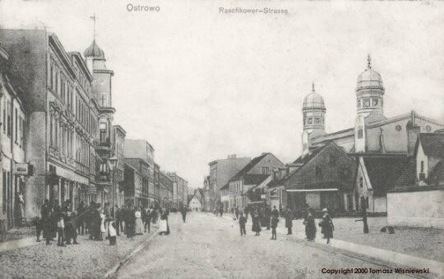Country Poland Town rights 15th century Area 41.9 km² Local time Monday 7:52 PM | Established 14th century Highest elevation 175 m (574 ft) Population 72,360 (2008) | |
 | ||
County Ostrów Wielkopolski County Gmina Ostrów Wielkopolski (urban gmina) Weather 11°C, Wind W at 10 km/h, 58% Humidity Voivodeship | ||
czno ariss 08 01 2014 ostr w wielkopolski
Ostrów Wielkopolski ([ˈɔstruf vʲɛlkɔˈpɔlskʲi]) (often abbreviated Ostrów Wlkp., formerly called only Ostrów, German: Ostrowo, Latin: Ostrovia) is a city in central Poland with 72,360 inhabitants (2008), situated in the Greater Poland Voivodeship; the seat of Ostrów Wielkopolski County.
Contents
- czno ariss 08 01 2014 ostr w wielkopolski
- Map of Ostrow Wielkopolski Poland
- History
- Notable residents
- Education
- Sports
- Twin towns sister cities
- References
Map of Ostrow Wielkopolski, Poland
History
Recently, a small fortified dwelling dating from the 10th century was discovered on the north-east side of the town's limits. An archeological excavation is now in progress.
Ostrów received town privileges in 1404 but the economic stagnation caused by fires, wars, and a weak 16th-century nobility, led to the town’s officials dropping its town status in 1711. In 1714, one of the nobility of Ostrów, Jan Jerzy Przebendowski, intervened at the royal court, for the status to be reinstated. By the power of a Royal Marshall (English: Marshal), Franciszek Bielinski, the town received its status back with greater privileges. Another noble family, the Radziwiłłowie took patronage over the town and looked over its many investments. The care of the town’s owners, work of its people, and dedication of its officials, as well as its location, favored the town’s continuous growth. The establishment of a railroad hub in Ostrów was a vital turning point in its development, helping to lend the town prominent status on the local and national scene.
During the time of Partition and both World Wars, Ostrów became an important center for nationalist movements. One of the town’s historic episodes was the so-called Republic of Ostrów (Republika Ostrowska), which was the citizens’ upheaval of 1918. No blood was shed at that upheaval and all political powers were taken over from the Prussian authorities. In between the First and Second World Wars, Ostrów was one of the fastest growing towns: the number of inhabitants doubled, showy houses were built and modern railcar manufacturing (Fabryka Wagon) began.
During World War II, a Nazi labor camp, Staatspolizeistelle Litzmannstadt Arbeitserziehungslager Ostrowo, operated within the town's limits, where 193 people died. The town was one of the major anti-Nazi conspiracy centers in the Great Poland region. In 1941, after the Gestapo's crackdown on the headquarters of the Poznań branch of the underground army Union for Armed Struggle-ZWZ, the headquarters were moved to Ostrów. From here the re-structure of the Poznań region of the Union was conducted.
Notable residents
Education
Sports
From 5 July to 20 July 2013 Ostrów Wielkopolski hosted the 17th European Gliding Championships. The local pilot, Łukasz Błaszczyk, took a bronze medal in the Club Class.
Twin towns — sister cities
Ostrów Wielkopolski is twinned with:
